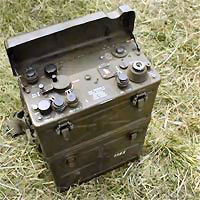What the heck did "S-3Able" mean in the Korean War?
From: "Sully", piedpiper6@the-i.net
To: "Bert Kortegaard", korteng@rt66.com
Subject: Radio Call Signs....
Date: Tue, 9 Jan 2001 21:04:50 -0600
Bert:
The basic staff structure (function categories and corresponding numerical designations) of many military units is as follows:
1 Personnel
2 Intelligence
3 Operations
4 Logistics
5 Civil Affairs
6 Commanding Officer
S At battalion and regimental level the 1 thru 5 inclusive are indicated as S-1, S-2, ..
G At Division, Corps and upper echelons the numbers are preceded by a G.
A To indicate an assistant in a staff position you attached "Able."
| Thus "S-3Able" designated the Assistant Operations Officer of a battalion or regiment. |
(During WW II there was a system in place which in many ways was clearer than the system above which succeeded it. Thus, the B-1 was a Battalion Personnel Officer, the R-2 was a Regimental Intelligence Officer, the D-3 was a Division Operations Officer, the C-4 a Corps Logistics Officer.)
In Vietnam, my battalion's radio call sign was "Pied Piper" at the time we were the only US combat element operating north of Hue. My radio on the Battalion Tactical Net answered to a call for "Pied Piper 6." Let's reconstruct what was a typical conversation of a battalion moving up the "Street Without Joy" northeast of Hue.
"Pied Piper 6, this is Alfa 6 Actual. Let me speak to your Actual. Over."
"This is Pied Piper 6. My Actual is with the connecting file. Wait one."
"This is 6 Actual, What's up Clancy (Alfa 6's first name)? Over."
"Skipper, I've got some movement across the paddy, and can't determine who they are. I'd like to send a squad over and check. What do you think? Over."
"Clancy, those dudes have got to be 300 meters off aren't they? Over."
"That's a Roger. Over."
"OK Clancy, if you see a weapon cut down on them and I'll hold the column until we learn what you've grabbed by the tail and whether you need fire support. Keep your Arty and Mortar FOs up close and advised. I'll tell my ArtyLnO and FAC what the situation is and maybe we can get a Bird Dog over there to see if they can pick up anything from the air. If we do get a Bird Dog we'll have him come up on your Company Tac Net and you can direct. Copy? Over."
At that point I'd click the handphone once to acknowledge his Out and hand the phone back to the radio operator.
Purists will point out that proper radio procedure was not used in the foregoing, and they'd be right. But we communicated, and that was what was important, not repeating a bunch of useless trash and taking up a bunch of time.
If you need anything more than the foregoing shoot up a red flare. SF Sully

SCR-300, battery powered FM Radio Transmitter
BC-1000: 40-48 Mhz, 35 pounds, 10 mile range.
|
Don't know if you include anywhere on your pages anything on radio comm in Korea. The only two radios that I can speak of with any knowledge are the SCR 300 and SCR 536. The latter was used on the Company Tac Net, and the former on Battalion and Regimental Tac Nets.
The 536 ("Handy Talky") was essentially worthless and notorious for not working when you really needed them. The 300 was pretty much line of sight, and if both radios were on a hill somewhere with no intervening land masses they worked to a distance of 6,000 meters or so. Get either radio across a high ridge from the other, even though a 1,000 meters or less point to point and you could forget comm.
The ArtyLnO and FAC had radios that were jeep mounted, with the radio taking up the entire rear seat. Of course these were the tube variety which meant that every time they were moved over rough terrain they required maintenance before you could get them to work again. SF Sully

